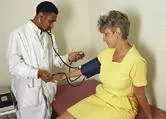Single-pill approach, large patient registry among key points for success in study
WebMD News from HealthDay

By Kathleen Doheny
HealthDay Reporter
TUESDAY, Aug. 20 (HealthDay News) -- The rate of blood-pressure control among adults with hypertension who took part in an intensive program offered by their health maintenance organization nearly doubled in nine years, according to a new study.
One key part of the program is treating patients with a single combination blood-pressure pill, which is easier than taking multiple pills for the same condition.
"This study suggests that if you have high blood pressure, there is hope," said study researcher Dr. Marc Jaffe, an endocrinologist and clinical leader of the cardiovascular risk reduction program for Kaiser Permanente Northern California.
From 2001 through 2009, the blood-pressure control rate of those participating in the program increased from about 43 percent to more than 80 percent, Jaffe said. "I would say it's a phenomenal increase," he said. By 2011, the control rate was even higher, at 87 percent.
Jaffe's team compared that control rate to a national database that found that blood-pressure control increased much less among the general population during the same time period, from 55 percent to 64 percent.
For the study, control was defined as a pressure less than 140/90 millimeters of mercury (mmHg) while on medication. Ideally, pressure should be below 120/80 in the general population.
The study is published in the Aug. 21 issue of the Journal of the American Medical Association.
Hypertension, which increases the risk of heart attacks and strokes, affects about 29 percent of adult Americans, or 65 million people, the researchers said.
The program had five key points, Jaffe said. It established a comprehensive hypertension registry to identify patients with high blood pressure. Between 2001 and 2009, the registry increased from about 350,000 adults to about 652,000 among Kaiser's Northern California facilities. The average age of patients was 63.
It also promoted the prescription of a single combination blood-pressure pill, known from other research to work well. It included lisinopril (brand names include Prinivil and Zestril) and hydrochlorothiazide (Microzide, Esidrix). "We know a single pill is easier to remember," Jaffe said. It may also be more affordable, with one drug co-pay instead of two or more, he said.
The program also traded information about successful strategies among clinics. Kaiser clinics that achieved high rates of control shared their practices with other clinics, which then initiated them. The program also used evidence-based practice guidelines in guiding treatment.
Medical assistants were used for follow-up visits to monitor blood pressure. The medical assistants were not registered nurses or licensed vocational nurses, but were specially trained personnel who monitored blood pressure and other vital signs, Jaffe said.
"I think a lot of these components would be applicable to other centers," he said. Although the study did not examine whether blood-pressure control results in cost savings due to fewer hospitalizations and other fees, Jaffe said he believes it would.
source : Program Boosts Blood-Pressure Control for Patients








